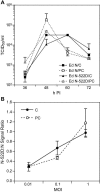A single codon in the nucleocapsid protein C terminus contributes to in vitro and in vivo fitness of Edmonston measles virus
- PMID: 16501099
- PMCID: PMC1395441
- DOI: 10.1128/JVI.80.6.2904-2912.2006
A single codon in the nucleocapsid protein C terminus contributes to in vitro and in vivo fitness of Edmonston measles virus
Abstract
The major inducible 70-kDa heat shock protein (hsp72) increases measles virus (MV) transcription and genome replication. This stimulatory effect is attributed to hsp72 interaction with two highly conserved hydrophobic domains in the nucleocapsid protein (N) C terminus of Edmonston MV. These domains are known as Box-2 and Box-3. A single amino acid substitution in Box-3 of Edmonston MV (i.e., N522D) disrupts hsp72 binding. The prevalence of the N522D substitution in contemporary wild-type MV isolates suggests that this sequence has been positively selected. The present work determined if the N522D substitution enhances viral fitness and the degree to which any fitness advantage is influenced by hsp72 levels. Both parent Edmonston MV (Ed N) and an N522D substitution mutant (Ed N-522D) exhibited similar growth on Vero and murine neuroblastoma cells and in cotton rat lung, although Ed N-522D virus exhibited an attenuated in vitro response to hsp72 overexpression. In contrast, mixed infections showed a significantly reduced in vitro and in vivo fitness of Ed N-522D virus. Results support the involvement of additional selectional pressures that maintain the circulation of virus containing N-522D despite the cost to viral fitness.
Figures








Similar articles
-
hsp72, a host determinant of measles virus neurovirulence.J Virol. 2006 Nov;80(22):11031-9. doi: 10.1128/JVI.01438-06. Epub 2006 Sep 13. J Virol. 2006. PMID: 16971451 Free PMC article.
-
Hsp72 recognizes a P binding motif in the measles virus N protein C-terminus.Virology. 2005 Jun 20;337(1):162-74. doi: 10.1016/j.virol.2005.03.035. Virology. 2005. PMID: 15914229
-
V and C proteins of measles virus function as virulence factors in vivo.Virology. 2000 Feb 1;267(1):80-9. doi: 10.1006/viro.1999.0118. Virology. 2000. PMID: 10648185
-
Nucleocapsid structure and function.Curr Top Microbiol Immunol. 2009;329:103-28. doi: 10.1007/978-3-540-70523-9_6. Curr Top Microbiol Immunol. 2009. PMID: 19198564 Review.
-
Toward understanding the pathogenicity of wild-type measles virus by reverse genetics.Jpn J Infect Dis. 2002 Oct;55(5):143-9. Jpn J Infect Dis. 2002. PMID: 12501253 Review.
Cited by
-
Heat shock protein 70 regulates degradation of the mumps virus phosphoprotein via the ubiquitin-proteasome pathway.J Virol. 2015 Mar;89(6):3188-99. doi: 10.1128/JVI.03343-14. Epub 2014 Dec 31. J Virol. 2015. PMID: 25552722 Free PMC article.
-
Previously unrecognized amino acid substitutions in the hemagglutinin and fusion proteins of measles virus modulate cell-cell fusion, hemadsorption, virus growth, and penetration rate.J Virol. 2009 Sep;83(17):8713-21. doi: 10.1128/JVI.00741-09. Epub 2009 Jun 24. J Virol. 2009. PMID: 19553316 Free PMC article.
-
Major histocompatibility complex haplotype determines hsp70-dependent protection against measles virus neurovirulence.J Virol. 2009 Jun;83(11):5544-55. doi: 10.1128/JVI.02673-08. Epub 2009 Mar 25. J Virol. 2009. PMID: 19321604 Free PMC article.
-
How order and disorder within paramyxoviral nucleoproteins and phosphoproteins orchestrate the molecular interplay of transcription and replication.Cell Mol Life Sci. 2017 Sep;74(17):3091-3118. doi: 10.1007/s00018-017-2556-3. Epub 2017 Jun 9. Cell Mol Life Sci. 2017. PMID: 28600653 Free PMC article. Review.
-
hsp70-dependent antiviral immunity against cytopathic neuronal infection by vesicular stomatitis virus.J Virol. 2013 Oct;87(19):10668-78. doi: 10.1128/JVI.00872-13. Epub 2013 Jul 24. J Virol. 2013. PMID: 23885078 Free PMC article.
References
-
- Bourhis, J. M., K. Johansson, V. Receveur-Brechot, C. J. Oldfield, K. A. Dunker, B. Canard, and S. Longhi. 2004. The C-terminal domain of measles virus nucleoprotein belongs to the class of intrinsically disordered proteins that fold upon binding to their physiological partner. Virus Res. 99:157-167. - PubMed
-
- Bourhis, J. M., V. Receveur-Brechot, M. Oglesbee, X. Zhang, M. Buccellato, H. Darbon, B. Canard, S. Finet, and S. Longhi. 2005. The intrinsically disordered C-terminal domain of the measles virus nucleoprotein interacts with the C-terminal domain of the phosphoprotein via two distinct sites and remains predominantly unfolded. Protein Sci. 14:1975-1992. - PMC - PubMed
-
- Carsillo, T., M. Carsillo, S. Niewiesk, D. Vasconcelos, and M. Oglesbee. 2004. Hyperthermic pre-conditioning promotes measles virus clearance from brain in a mouse model of persistent infection. Brain Res. 1004:73-82. - PubMed
-
- Diallo, A., T. Barrett, M. Barbron, G. Meyer, and P. C. Lefevre. 1994. Cloning of the nucleocapsid protein gene of peste-des-petits-ruminants virus: relationship to other morbilliviruses. J. Gen. Virol. 75:233-237. - PubMed
-
- Escarmis, C., M. Davila, and E. Domingo. 1999. Multiple molecular pathways for fitness recovery of an RNA virus debilitated by operation of Muller's ratchet. J. Mol. Biol. 285:495-505. - PubMed
Publication types
MeSH terms
Substances
Grants and funding
LinkOut - more resources
Full Text Sources

